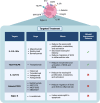Inflammatory and homeostatic roles of eosinophil subpopulations in chronic rhinosinusitis with nasal polyp pathogenesis
- PMID: 40292285
- PMCID: PMC12021798
- DOI: 10.3389/fimmu.2025.1568541
Inflammatory and homeostatic roles of eosinophil subpopulations in chronic rhinosinusitis with nasal polyp pathogenesis
Abstract
Chronic rhinosinusitis (CRS) with nasal polyps (CRSwNP) mainly expresses type-2 endotype, featuring eosinophils as a main player in the inflammatory process. Prolonged eosinophilia in the tissues of asthma and CRSwNP patients has been associated with structural changes, leading to fixed airflow obstruction in asthma and nasal polyposis in CRSwNP. This suggests that eosinophils may belong to different subgroups playing distinct roles in pathogenesis. Recent studies highlight the roles of inflammatory eosinophils (iEOS) in driving inflammation and tissue damage, whereas tissue-resident eosinophils (rEOS) maintain homeostasis and tissue repair in the airway. Therefore, understanding both roles of eosinophil subpopulations is crucial for better CRSwNP management, including enhancing the diagnosis accuracy, predicting recurrence, and optimizing treatment strategies.
Keywords: chronic rhinosinusitis with nasal polyps; eosinophil; eosinophil subpopulations; inflammatory eosinophils; resident eosinophils.
Copyright © 2025 Simmalee, Lumjiaktase, Kawamatawong, Guemari, Dormoy and Vitte.
Conflict of interest statement
VD reports consultancy fees, funding grants, and travel reimbursement in the past 5 years from Astra Zeneca, outside the submitted work. JV reports speaker and consultancy fees in the past 5 years from Astra Zeneca, HpVac, L’Oréal, Novartis, Thermo Fisher Scientific, Zambon, and travel expenses reimbursement from Stallergènes-Greer for an international meeting, outside the submitted work. The remaining authors declare that the research was conducted in the absence of any commercial or financial relationships that could be construed as a potential conflict of interest.
Figures


Similar articles
-
Amphiregulin Mediates Epithelial Cell-Eosinophil Interactions and Amplifies Inflammation in Chronic Rhinosinusitis With Nasal Polyps.Allergy. 2025 May;80(5):1335-1347. doi: 10.1111/all.16582. Epub 2025 May 2. Allergy. 2025. PMID: 40317745
-
Epithelium-derived cystatin SN enhances eosinophil activation and infiltration through IL-5 in patients with chronic rhinosinusitis with nasal polyps.J Allergy Clin Immunol. 2019 Aug;144(2):455-469. doi: 10.1016/j.jaci.2019.03.026. Epub 2019 Apr 8. J Allergy Clin Immunol. 2019. PMID: 30974106 Clinical Trial.
-
Single cell RNA sequencing of human eosinophils from nasal polyps reveals eosinophil heterogeneity in chronic rhinosinusitis tissue.J Allergy Clin Immunol. 2024 Oct;154(4):952-964. doi: 10.1016/j.jaci.2024.05.014. Epub 2024 May 24. J Allergy Clin Immunol. 2024. PMID: 38797240
-
Rethinking neutrophils and eosinophils in chronic rhinosinusitis.J Allergy Clin Immunol. 2021 Aug;148(2):327-335. doi: 10.1016/j.jaci.2021.03.024. Epub 2021 Apr 21. J Allergy Clin Immunol. 2021. PMID: 33895002 Free PMC article. Review.
-
Exploring the immunopathology of type 2 inflammatory airway diseases.Front Immunol. 2024 Apr 12;15:1285598. doi: 10.3389/fimmu.2024.1285598. eCollection 2024. Front Immunol. 2024. PMID: 38680486 Free PMC article. Review.
References
Publication types
MeSH terms
LinkOut - more resources
Full Text Sources
Medical

